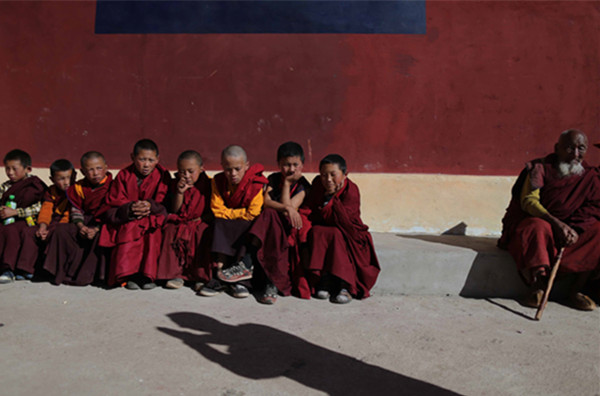Uninsured clergy face retirement crisis
 |
|
Monks at a temple in Ganzi Tibetan autonomous prefecture, Sichuan province. Clergy ill-prepared for retirement and lacking of health insurance is a problem in major religions in China, according to a report by Renmin University of China. [Photo by Wang Yuheng/China Daily] |
Father Francis Li Jianlin has been looking for investment opportunities and health insurance in his spare time, spurred on by a feeling of responsibility for the priests and nuns in his Catholic diocese in Xinxiang, Henan province.
Although the idea of retirement has barely crossed the mind of many of the clergy, Li, 41, as the most senior priest in the diocese under the Chinese Patriotic Catholic Association, said he must plan for the future well-being of the district's 12 priests and 10 nuns.
"The diocese has no fixed income, and funding has always been a problem. But on top of all those issues, I need to find a solution for them before they become old and without care," he said. "The issue has been all over my mind recently."
The most pressing matter, he said, is to purchase health insurance, as the cost increases with the applicant's age. The investment plans would also help hedge his diocese's finances against the risks of inflation.
"I need to find the best solution with very limited financial resources," he said.
Clergy ill-prepared for retirement and lacking of health insurance is a problem in all five major religions in China, including Buddhism, Taoism, Islam, Catholicism and Protestantism, according to a June report by Renmin University of China.
According to the China Religious Survey, more than 40 percent of religious institutions in China have not purchased pension plans for their clergy and more than 26 percent have not bought medical insurance. The survey polled 4,383 religious venues in 243 counties or districts across the country over the past 18 months.
In China, 360,000 people are classified as clergy, according to a white paper issued by the State Council Information Office in 2013.
According to the Renmin University report, Taoism has the lowest percentage of social security coverage, as less than 63 percent of religious venues have purchase such plans for their clergy.
Zhang Fenglin, vice-president and secretary-general of the Taoist Association of China, said the idea of retirement has never occurred to many Tao clergymen, especially those in the Quanzhen School.
The situation varies widely between regions. Taoist temples in Suzhou, Jiangsu province, for example, have health and pension plans for their clergy, while some Taoist temples cannot even afford meager allowances for their priests.
The pervasive view toward retirement has long been that if a priest committed his life to religious service, the temple should be take care of him in old age, Zhang said.
However, it is now recognized that social insurance plans are needed to avert a potential crisis among aging clergy, he said.
"In the future, the burden would be huge for the Taoist temples nationwide if young people keep joining and we also have to take care of the aged priests," Zhang said.






















